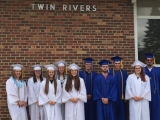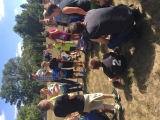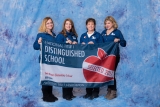-
Category 2
Selected in 2017
-
Grades: k - 5
School Setting: rural
Town Population: 1,500
Student Enrollment: 199
Student Demographics:
Black/African American: 2%
Teacher/Student Ratio: 1:28
White/Caucasian: 90%
Hispanic: 6%
Hawaiian/Pacific Islander: 0%
Asian: 0%
Native American: 0%
Other: 2%
% Reduced Lunch: 80%
% ELL Learners: 2%
Founded: 1952 -
PRINCIPAL:
Dayna Ellis -
CONTACT:
435 Lou Lemke Lane
Muir, MI 48860
616-522-0005
dellis@ioniaschools.org
Twin Rivers Elementary School
Muir, MI
Many of our best school improvement adjustments have come from teachers trying new things and sharing them with their colleagues.
- Describe specific programs in place to ensure that families are involved in the success of your school and students.
-
We have a very strong parent organization called the FSO, which stands for Family School Organization. Parents, teachers and community members participate on this committee. This committee organizes and participates in many events that include our families. Events like our annual Fall Fest and Carnival bring in many of our families, often along with their extended family members - grandparents, cousins, aunts, etc. They also organize a Family Game Night and Movie Night that are well attended.
Title I funds are used to support parents as they work to help their children learn at home. We have supported a Take Home Reading Program for the last 10 years and have utilized Math Binders for the last five years that give parents class activities, the glossary and other resources that can be used to help with each homework assignment. We have also held multiple curriculum night, specifically following the adoption of new curriculum programs. - Describe the most successful activity your school has initiated to strengthen ties to your community.
-
Our school is the only school in our small community. There is one grocery store, one restaurant, one gas station, one doctor's office, three churches and a few small businesses. In all of these places, owners, workers and worshipers have children or grandchildren attending (or have attended) Twin Rivers. It is a natural connection that has been evolving for the last 50+ years.
Each fall we hold our annual Fall Fest and in the winter our annual Carnival. Past student, parents and grandparents along with those currently attending Twin Rivers, join in on the fun. Lunch is served, games, face painting and crafts are available for the children, with volunteers from the community helping out.
When we celebrated being a Reward School, we wanted to buy every student a t-shirt. We reached out to the local community for financial support. We raised enough money within one week of reaching out. T-shirts were purchased for donors, and the event was packed with community members. - Describe your philosophy of school change or improvement.
-
School change takes time. There are five elementary schools in our district, so many big changes come from the district level. Teachers and administrators are able to give input on these decisions. When new curriculum is adopted, district provided professional develop gives teachers the information they need to utilize the program. At Twin Rivers, we have worked hard to deliver our reading and math curricula with fidelity, using as many of the provided materials as possible. We do not add in pieces from other programs. We believe that it could be 3-5+ years before we see the true effects of new curricula.
Though school improvement should be based on research-based concepts/programs/ideas, many of our best school improvement adjustments have come from teachers trying new things and sharing them with their colleagues. These ideas grow and improve and take over. We could probably find research on these ideas, we used them because they made sense. - What are your school’s top two goals for the next year?
-
Two goals for next year are ..
To get the book The Learning Habit: A Groundbreaking Approach to Homework and Parenting That Helps Our Children Succeed in School and Life, by Donaldson-Pressman, Jackson and Pressman, into each household with a Twin Rivers student. A book study will be held using a discussion blog. This book focuses on students' use of media, the importance of sleep and exercise and most importantly about how families should manage homework at home. This will require teachers to adjust their expectations for homework completion. We are hoping to work together to impact what happens when our students are at home.
Our second goal will be to increase our focus on literacy, using strategies from the Reading Now Network, the Essential Instructional Practices for Early Literacy and the Michigan 3rd Grade Reading Law. This year we've increased reading instructional time from 60 minutes to 90 minutes. This time is uninterrupted. - What is the single most important factor in the success of your school that others could replicate?
- In my opinion, our success has come from getting students involved in their own education. Students are no longer passive learners. All students answer questions through "turn and talks" verses just one student. Students are involved in the instruction, through being leaders of the day or the teacher's assistant. Students also know all of their testing results, including their current score and what it should have been. Students then plan and discuss goals for their learning. On top of this, students are made aware of the learning targets for each lesson and what success will look like if they accomplish or master this target.
- Describe the program or initiative that has had the greatest positive effect on student achievement, including closing achievement or opportunity gaps, if applicable.
- Our greatest change came when we began focusing on student engagement. A couple of teachers began utilizing "turn and talks" in their classrooms, keeping all students involved in the discussion verses the few that get called on through the usual process. As the administrator, I noticed huge increases in student engagement when "turn and talks" were used. I shared this information with other teachers at our school improvement meetings, and all teachers have found ways to keep students actively engaged. Turn and talks, having students introduce vocabulary words, having students correct homework together and discuss differences and letting students lead the instruction as much as possible have increased students' involvement in their learning, and, we feel, has had a significant impact on their achievement.
- Explain how Title I funds are used to support your improvement efforts.
-
We utilize Title I funds to hire highly qualified paraprofessionals and/or interventionists to primarily support students who are struggling with current grade level skills in both reading and math. As soon as a student begins to struggle, they are given additional practice until they have mastered the skill. These paraprofessionals and/or interventionists also assist students who well behind their peers (often these are students that have moved in from other schools or districts).
We also utilize Title I funds to support an after-school program that involves 30-35 of our lowest students. Students stay after-school for an hour two days a week to accomplish homework and get extra reading practice in. We provide a snack and have built in a few fun days to reward students for their hard work. We know that most of these students do not have parents that can help them with their homework. This afterschool program has modeled for students how to get the work done. - Identify the critical professional development activities you use to improve teaching and student learning.
-
For the last three years, our district has given school teams half a day each month to collaborate with each other. We use professional learning communities to plan for to meet the learning needs of all students - below grade level, at grade level and above grade level. Teachers and Title I staff work together to make these plans, and each team shares their plans with the principal. Prior to PLC meetings, teachers and Title I staff never had much time to discuss students and important details surrounding their work.
PLC time is also used to look at student data, decide what each student needs to work on and then makes a plan to make it happen. - Describe how data is used to improve student achievement and inform decision making.
-
For the last several years, we have utilized STAR 3-5 times a year to monitor student growth in the areas of reading and math. We started using this data to drive teacher instruction, but for the last six years we have empowered students to use this data, as well as, their teachers.
We are now in our second year of using NWEA, and we assess students three times a year. Students know their score and what their score should have been for each testing cycle. Students chart their scores, set goals for the next cycle and discuss with their teachers what they can do to meet their goal.
Students are also aware of their progress on other classroom assessments such as spelling tests, sight word work, accelerated reading tests, etc.
Parents are also made aware of this data, as well. - Describe your school culture and explain changes you’ve taken to improve it.
-
I would describe our school environment as caring and loving. We have learned that at the elementary school age, children learn best through educational moments. Staff tries very hard to stay calm, patient and caring when working with students, both academically and behaviorally.
We also utilize a program district-wide called Capturing Kids' Hearts. Ultimately, you examine, at all levels, how people should treat each other. Following this program, we have learned that you must capture a student's heart before you capture their mind. Teachers greet students at their door every morning, open the floor for the sharing of "good news" every day and every classroom writes a social contract for the school year. Students sign the contract, showing their agreement to follow it.
Staff members also follow this program format, creating a social contract, signing it and following it at staff and school improvement meetings, as well as, throughout the school day.
Stats
-
Category 2
Selected in 2017
-
Grades: k - 5
School Setting: rural
Town Population: 1,500
Student Enrollment: 199
Student Demographics:
Black/African American: 2%
Teacher/Student Ratio: 1:28
White/Caucasian: 90%
Hispanic: 6%
Hawaiian/Pacific Islander: 0%
Asian: 0%
Native American: 0%
Other: 2%
% Reduced Lunch: 80%
% ELL Learners: 2%
Founded: 1952 -
PRINCIPAL:
Dayna Ellis -
CONTACT:
435 Lou Lemke Lane
Muir, MI 48860
616-522-0005
dellis@ioniaschools.org










